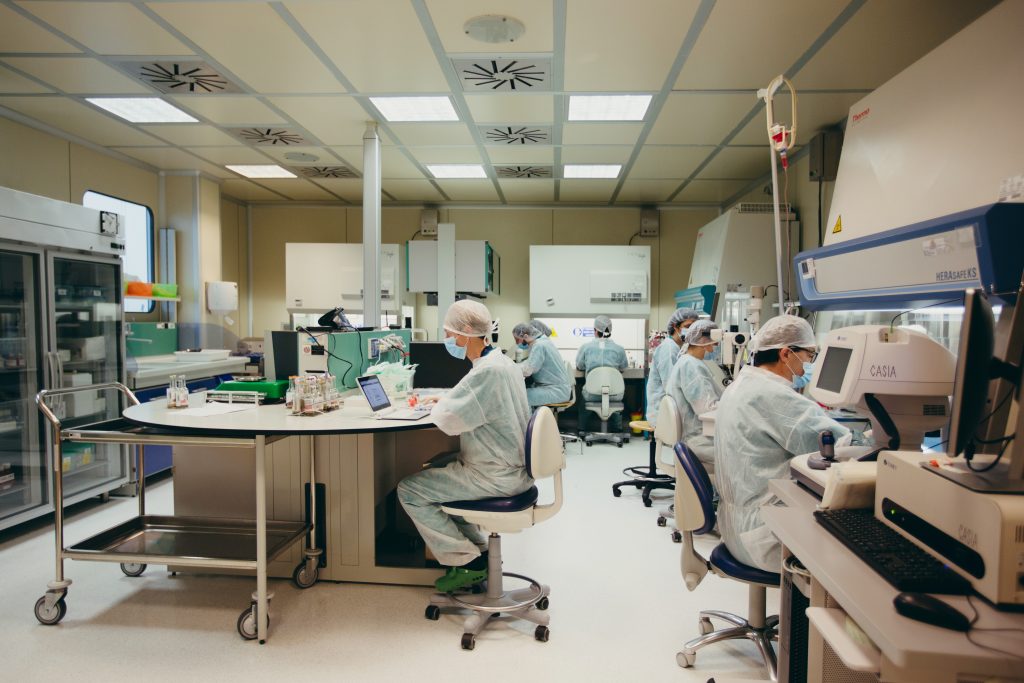Eye banking and COVID-19
Donor and operating protocols ensure provision of safe tissue

Howard Larkin
Published: Monday, February 1, 2021
[caption id="attachment_22075" align="alignleft" width="1024"] A busy day at the Veneto Eye Bank Foundation, Venice. Image property: the Veneto Eye Bank Foundation[/caption]
Given appropriate precautions, corneal transplantation and eye banking are safe in the COVID-19 era, Diego Ponzin MD told the 38th Congress of the ESCRS Virtual. New methods of extending the shelf life of corneal tissues are also making progress, said Dr Ponzin, who is medical director of Veneto Eye Bank, Venice, Italy.
“Current eye banking practices allow for continuation of provision of safe corneal tissues,” Dr Ponzin said. These practices include protocols Veneto developed to ensure a COVID-19-free route to corneal transplantation that affect donors, recipients and staff.
Donors are deferred if they have a positive post-mortem nasopharyngeal swab or had active COVID-19 symptoms or risk factors. Donors with close contacts with infected individuals are acceptable if those contacts were at least four weeks past and they have a negative nasopharyngeal test.
Cornea recipients receive an outpatient nasopharyngeal swab on day one. Procedures are performed as day surgery under local anaesthesia with no ICU personnel to minimise the risk of in-hospital contagion or spread. Patients then receive a COVID-19 serology test 30 days after surgery to ensure no transmission has occurred.
Eye bank staff follow strict social distancing, personal protective equipment and disinfection guidelines, and are thoroughly trained in infection control procedures. The staff has been divided into two groups that work on alternate days, Dr Ponzin said.
A busy day at the Veneto Eye Bank Foundation, Venice. Image property: the Veneto Eye Bank Foundation[/caption]
Given appropriate precautions, corneal transplantation and eye banking are safe in the COVID-19 era, Diego Ponzin MD told the 38th Congress of the ESCRS Virtual. New methods of extending the shelf life of corneal tissues are also making progress, said Dr Ponzin, who is medical director of Veneto Eye Bank, Venice, Italy.
“Current eye banking practices allow for continuation of provision of safe corneal tissues,” Dr Ponzin said. These practices include protocols Veneto developed to ensure a COVID-19-free route to corneal transplantation that affect donors, recipients and staff.
Donors are deferred if they have a positive post-mortem nasopharyngeal swab or had active COVID-19 symptoms or risk factors. Donors with close contacts with infected individuals are acceptable if those contacts were at least four weeks past and they have a negative nasopharyngeal test.
Cornea recipients receive an outpatient nasopharyngeal swab on day one. Procedures are performed as day surgery under local anaesthesia with no ICU personnel to minimise the risk of in-hospital contagion or spread. Patients then receive a COVID-19 serology test 30 days after surgery to ensure no transmission has occurred.
Eye bank staff follow strict social distancing, personal protective equipment and disinfection guidelines, and are thoroughly trained in infection control procedures. The staff has been divided into two groups that work on alternate days, Dr Ponzin said.
 The ultimate keratoplasty: preloaded donor tissue for
Descemet Membrane Endothelial Keratoplasty, ready
to be shipped. Image property: the Veneto Eye Bank Foundation
DONATIONS
The approach enabled Veneto to continue recovering and distributing corneal tissue throughout the COVID-19 crisis, Dr Ponzin said. Donations during 100 days studied fell 25% to 1,233 and distributions 44% to 735 compared with 2019.
Maintaining operations was easier and better met patient needs than shutting down and trying to restart the programme, he added. This was especially important because Veneto is one of Europe’s largest eye banks, providing 51% of corneal tissues in Italy and exporting internationally.
FEW POSITIVES
Following these protocols, Veneto deferred 5% of donors for symptoms and 0.6% had positive post-mortem swabs. A study of 588 donors found three patients with positive swabs, and SARS-CoV-2 was detected in two corneas of two patients for a positivity rate of 0.3%. Dr Ponzin believes that even infected corneas may not transmit the virus to recipients.
“In my opinion the chances of transmission are negligible. Even when we found virus RNA in the donor cornea we could not isolate an infective form of the virus.”Anticipating longer times from donation to distribution, Veneto began research into extending storage time from 35 to 75 days by dehydrating some tissues. Validation is ongoing, though the studies appear to have succeeded, Dr Ponzin said.
But the crisis is not yet over, Dr Ponzin said. “We must keep very vigilant and monitor the pandemic indicators on a daily basis.”
Diego Ponzin: diego.ponzin@fbov.it
The ultimate keratoplasty: preloaded donor tissue for
Descemet Membrane Endothelial Keratoplasty, ready
to be shipped. Image property: the Veneto Eye Bank Foundation
DONATIONS
The approach enabled Veneto to continue recovering and distributing corneal tissue throughout the COVID-19 crisis, Dr Ponzin said. Donations during 100 days studied fell 25% to 1,233 and distributions 44% to 735 compared with 2019.
Maintaining operations was easier and better met patient needs than shutting down and trying to restart the programme, he added. This was especially important because Veneto is one of Europe’s largest eye banks, providing 51% of corneal tissues in Italy and exporting internationally.
FEW POSITIVES
Following these protocols, Veneto deferred 5% of donors for symptoms and 0.6% had positive post-mortem swabs. A study of 588 donors found three patients with positive swabs, and SARS-CoV-2 was detected in two corneas of two patients for a positivity rate of 0.3%. Dr Ponzin believes that even infected corneas may not transmit the virus to recipients.
“In my opinion the chances of transmission are negligible. Even when we found virus RNA in the donor cornea we could not isolate an infective form of the virus.”Anticipating longer times from donation to distribution, Veneto began research into extending storage time from 35 to 75 days by dehydrating some tissues. Validation is ongoing, though the studies appear to have succeeded, Dr Ponzin said.
But the crisis is not yet over, Dr Ponzin said. “We must keep very vigilant and monitor the pandemic indicators on a daily basis.”
Diego Ponzin: diego.ponzin@fbov.it
 A busy day at the Veneto Eye Bank Foundation, Venice. Image property: the Veneto Eye Bank Foundation[/caption]
Given appropriate precautions, corneal transplantation and eye banking are safe in the COVID-19 era, Diego Ponzin MD told the 38th Congress of the ESCRS Virtual. New methods of extending the shelf life of corneal tissues are also making progress, said Dr Ponzin, who is medical director of Veneto Eye Bank, Venice, Italy.
“Current eye banking practices allow for continuation of provision of safe corneal tissues,” Dr Ponzin said. These practices include protocols Veneto developed to ensure a COVID-19-free route to corneal transplantation that affect donors, recipients and staff.
Donors are deferred if they have a positive post-mortem nasopharyngeal swab or had active COVID-19 symptoms or risk factors. Donors with close contacts with infected individuals are acceptable if those contacts were at least four weeks past and they have a negative nasopharyngeal test.
Cornea recipients receive an outpatient nasopharyngeal swab on day one. Procedures are performed as day surgery under local anaesthesia with no ICU personnel to minimise the risk of in-hospital contagion or spread. Patients then receive a COVID-19 serology test 30 days after surgery to ensure no transmission has occurred.
Eye bank staff follow strict social distancing, personal protective equipment and disinfection guidelines, and are thoroughly trained in infection control procedures. The staff has been divided into two groups that work on alternate days, Dr Ponzin said.
A busy day at the Veneto Eye Bank Foundation, Venice. Image property: the Veneto Eye Bank Foundation[/caption]
Given appropriate precautions, corneal transplantation and eye banking are safe in the COVID-19 era, Diego Ponzin MD told the 38th Congress of the ESCRS Virtual. New methods of extending the shelf life of corneal tissues are also making progress, said Dr Ponzin, who is medical director of Veneto Eye Bank, Venice, Italy.
“Current eye banking practices allow for continuation of provision of safe corneal tissues,” Dr Ponzin said. These practices include protocols Veneto developed to ensure a COVID-19-free route to corneal transplantation that affect donors, recipients and staff.
Donors are deferred if they have a positive post-mortem nasopharyngeal swab or had active COVID-19 symptoms or risk factors. Donors with close contacts with infected individuals are acceptable if those contacts were at least four weeks past and they have a negative nasopharyngeal test.
Cornea recipients receive an outpatient nasopharyngeal swab on day one. Procedures are performed as day surgery under local anaesthesia with no ICU personnel to minimise the risk of in-hospital contagion or spread. Patients then receive a COVID-19 serology test 30 days after surgery to ensure no transmission has occurred.
Eye bank staff follow strict social distancing, personal protective equipment and disinfection guidelines, and are thoroughly trained in infection control procedures. The staff has been divided into two groups that work on alternate days, Dr Ponzin said.
 The ultimate keratoplasty: preloaded donor tissue for
Descemet Membrane Endothelial Keratoplasty, ready
to be shipped. Image property: the Veneto Eye Bank Foundation
The ultimate keratoplasty: preloaded donor tissue for
Descemet Membrane Endothelial Keratoplasty, ready
to be shipped. Image property: the Veneto Eye Bank FoundationTags: eye banking
Latest Articles
Organising for Success
Professional and personal goals drive practice ownership and operational choices.
Update on Astigmatism Analysis
Is Frugal Innovation Possible in Ophthalmology?
Improving access through financially and environmentally sustainable innovation.
Making IOLs a More Personal Choice
Surgeons may prefer some IOLs for their patients, but what about for themselves?
Need to Know: Higher-Order Aberrations and Polynomials
This first instalment in a tutorial series will discuss more on the measurement and clinical implications of HOAs.
Never Go In Blind
Novel ophthalmic block simulator promises higher rates of confidence and competence in trainees.
Simulators Benefit Surgeons and Patients
Helping young surgeons build confidence and expertise.
How Many Surgeries Equal Surgical Proficiency?
Internet, labs, simulators, and assisting surgery all contribute.
Improving Clinical Management for nAMD and DME
Global survey data identify barriers and opportunities.